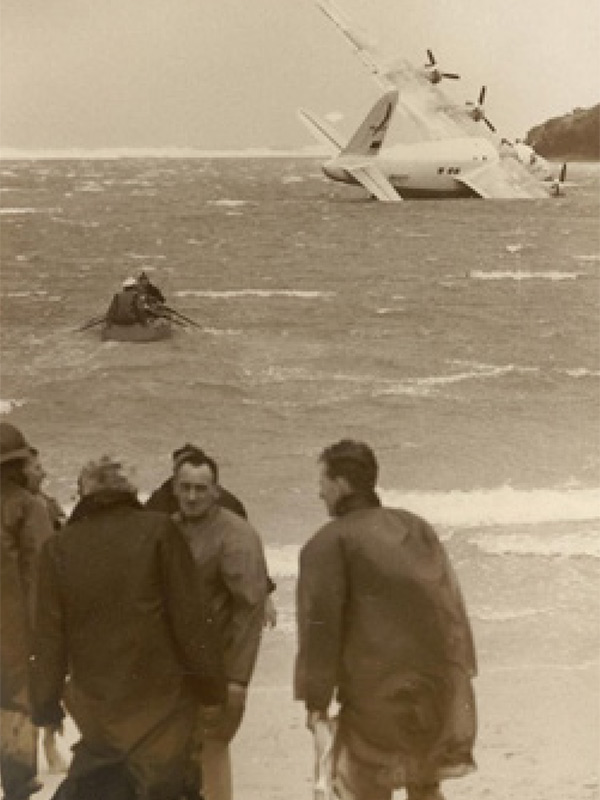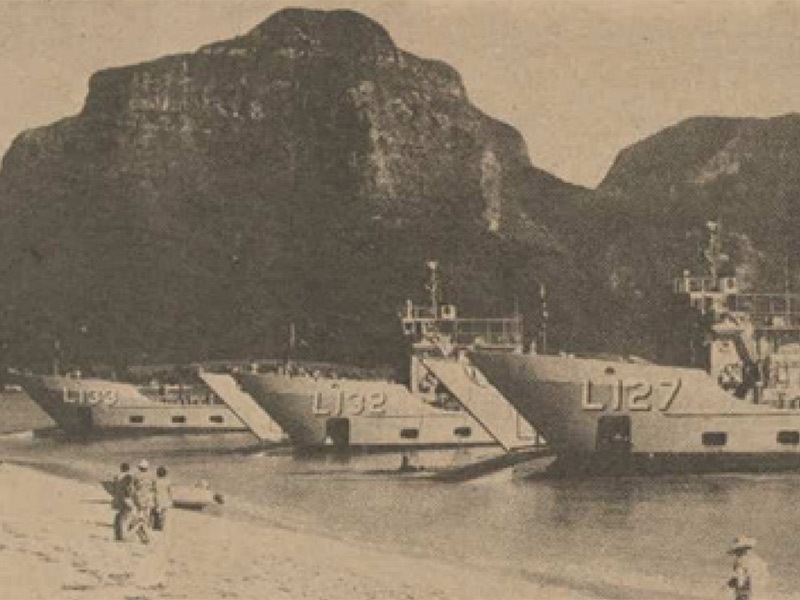By Clive Wilson
24th September 2024
Dear Stevie,
I would like to make several comments regarding the early flying boat services to the Island.
The first commercial flying boat operation to the Island landed in late December, 1946. This aircraft was a reconditioned Catalina, piloted by Captain Hugh Birch for a company which had been formed on the Island and included a number of locals, having the name of “Marinair”.
There were 8 passengers and 4 crew. However, whilst the aircraft was at the Island, Captain Birch received a message from Qantas Airlines management to take the job as senior flying boat captain for that airline. This was an offer he could not refuse and the Marinair venture folded before it ever really started. It was a sad ending to a very positive move forward for this community.
Rumours were rife on the Island about several companies, namely TOA (Trans Oceanic Airways) and Qantas, being interested in commencing services to the Island. In August, 1947, Captain Brian Monkton and his crew landed a converted Sunderland on the lagoon on a falling tide without approval from anyone. Then, in November of 1947, a converted Qantas Catalina landed in the Lagoon as a proving flight for a proposed service to the Island.
From the very outset there was strong disagreement in the Island community regarding having two services operating to the Island and the requisite licencing by the Department of Civil Aviation for the proposed flying boat operations.
Captain Monkton and his crews on the converted Sunderlands seemed to have the edge on the smaller Qantas Catalinas. However, from the outset there were rumours of their limited financial backing from the business family of Burleigh’s Limited ownership.
The weather was always a limiting factor for operations and, in June / July of 1949, things came to a head when a TOA Sunderland and a Qantas Catalina were both delayed at the Island overnight with a strong front approaching.
Captain Monkton and his crew stayed on their aircraft and saved it from a disaster by taxiing it on the Lagoon all through the night hours, with the support of the local DCA launch crew. The aircraft was safely taxied in winds and rough seas and, when daylight came, the aircraft took off on a very rough lagoon and was flown back to Sydney safely.
The Qantas Catalina was on the mooring closest to the jetty and rode out the first night, but the stormy weather continued for the second night. The aircraft, which had no crew on board, broke away and was blown ashore south of the jetty – onto the rocks and concrete wall – and quickly became a write off.

Qantas sent two engineers to the Island and they salvaged what they could, including the engines and other moveable fittings.
The captain of that aircraft, Laurie Clarke, was totally distraught at what had happened as he and his crew had attempted to board the aircraft. However, with a strong north westerly wind blowing, their attempt failed and he actually had to be rescued from the water by the Island launch crew supporting the Qantas operation. Claims and counter claims were rife on the Island regarding what had caused the mishap. There is no doubt, though, that the force of the wind, and the very large sea coming in the Lagoon, caused the aircraft to break away.
Several weeks later, residents of Rose Bay and surrounding suburbs were awakened by a loud explosion and a subsequent fire on board another Qantas converted aircraft. Subsequent investigations by authorities concluded that the aircraft had been blown up, and the Rose Bay community and the Island were steeped in controversy.
There was a court case over the incident. Captain Monkton was charged and tried but escaped any punitive action – however it was the beginning of the end for TOA. Burleigh’s withdrew their financial support for family reasons and then the loss of a Solent flying boat in Malta in rough conditions hastened the final demise and liquidation of the Company late in 1951 / 1952.
To rescue the passengers caught up in the closure of the TOA operations, Captain Phil Mathiesen and Captain Stuart Middlemiss arrived at the Island in Sandringham, VH-BRD, on the 11thof November, 1951. Captain Mathiesen announced that he had joined Qantas as one of their senior flying boat captains and Captain Middlemiss announced that he was joining forces with Reg Ansett (later Sir Reginald) to take up the service to Lord Howe Island. Ansett carried on the service for over 20 years with distinction.
This service was withdrawn in 1974 when the Island airport opened for land based operations.
Finally, Ansett Flying Boat Services from Rose Bay, despite periodic difficulties, proved a very successful venture and this community owed Captain Middlemiss and Sir Reginald Ansett a very large thank you for their persistence and consistency of safe operations to the Island until 1974.
A photograph in the August edition of The Signal states that the picture was taken of the TOA flying boat with passengers in the Albatross. The launch shown in that photograph is the “Loree”, at that time owned by the late Phil Dignam and the late Syd Morgan, which regularly serviced and supported the TOA operations to Lord Howe Island.

Some appropriate facts and comments covering Flying Boat Operations over the years:
Internal wrangling within the TOA Management and their crews over crewing and management issues, and when it was announced it was folding and ceasing services to LHI, controversy and strong disagreements continued.
The issues were representations to the Federal Government for financial assistance to support TOA. The other was to have Qantas services reinstated to support the Island Community.
Neither solution came to fruition with the Federal Government backing Barrier Reef Airlines, combining with Ansett Airlines, to take up the licences for Lord Howe Island and coastal services, including services to Tasmania. This solution proved only partially viable regarding Tasmania but, for Lord Howe Island, the solution proved viable for over 20 years despite periodic difficulties and mishaps.
In June, 1963, BRE broke away in a severe winter storm and became a total loss and was scuttled at sea off the Island.

After its modification and refurbishment it was christened “Islander”. (Photo courtesy P. Shields)
The Federal Government and AFBS combined in purchasing and refurbishing a war time Sunderland from the New Zealand Government. This aircraft came into service in early 1965 but, alas, in July, 1965, she broke away from her mooring in the Lagoon and suffered considerable damage on Lagoon Beach.
The situation was saved when Burns Philp agreed to the MV Tulagi making a special call to the island bringing an engine, a float and engineers to Lord Howe Island to carry out the engine change and float replacement.
The total cost of the operation to Ansett was over $200,000 as they paid all bills for the passengers stranded on Lord Howe Island. Also, the P&O cruise vessel “Orsova” made an aborted attempt to rescue the passengers from the island but this attempt failed due to terrible weather.
This incident resulted in the Commonwealth Government acknowledging the island’s need for an airport and a decision date for closing the flying boat service to the island. The Commonwealth Government and AFBS agreed on a change to the mooring system when flying boats were delayed at Lord Howe Island.
This again opened up controversy in the local community. However, DCA agreed to the AFBS suggestion regarding a substantial change, and that was carried out urgently for mooring the flying boats. It is worthy of note that, from 1965 to 1974, there were no further aircraft breakaways or beachings.
Comments on the situation change were muted but the decision of action on planning the runway became the main topic of the community – but this brought real high drama.
The unannounced arrival at the island of the Heavy Landing Ship, Vernon Sturdee, created much discussion and disagreement. The vessel’s C.O. asked permission to come into the Lagoon and tie up to the island jetty, but the Island moguls quite rightly refused to agree due to the size of the vessel which was almost 200ft long and had a draft of 6 ft 6 inches. However, the C.O. of the vessel sought further advice from the Naval Agent regarding their request. The Naval Agent, on being shown the sailing direction from the ADF, agreed to pilot the vessel into the Southern Lagoon via Erscott’s Passage. The Island moguls were incensed, however, on being shown the letters of direction for the visit which were signed by the Senior Officer of the Army Water Transport Division and the other by the Prime Minister, Sir Robert Menzies, brought in its train a change of heart with the acceptance of the contents of those letters by island authorities as it clearly stated that this was a precursor to establishing a viable system of getting heavy equipment and necessary supplies to the island for construction of an airport.
The proposal was that the Army would send a contingent of construction engineers who would be domiciled on the island and undertake the construction of the airport. The Navy would carry out carriage of heavy equipment and supplies using their new vessels – LCH’s – to maintain that support.
When construction was finished the RAAF would carry out the proving flights for the airport operation. The Federal and NSW Governments agreed in principle to this system and ultimately following the planning it was framed up and signed off for the contract in February, 1974. Though not without much local controversy and internal and external interference.
The first three LCH’s arrive in the Lagoon on March 7th, 1974. Were beached and unloaded near Windy Point and work began in earnest on Monday 8th March, 1974. The Island Resort, Leanda Lei, hosted the engineers and, overall, these people were a great credit to the ADF and despite months of terrible weather and several mishaps with the sea transport task the airport was completed in September 1974.
The changeover to land based operations was eased in using 2 x 4 engined Riley Heron’s chartered from the Northern Territory Airline, “Connellan Airways”, for a six-month period to March, 1975. Then came the King Air 200 era operated by Norfolk Island Airlines and the other Company being Advance/Avdev Airlines, but it should not be forgotten that Oxley Airlines of Port Macquarie, with their twin engine Navajos, played a key supportive role in servicing the island into the 1990’s. And then, all the while, the RAAF was supporting the island with air support for medivacs and other issues with their Caribous and C130’s. Then the Air Ambulance service began services to the island in the 1990’s.
This community must acknowledge that the land-based operations have, overall, been a great success over the last 50 years, and continue to be so.



